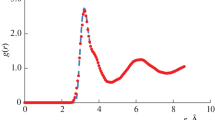Abstract
The homogeneous crystallization of liquid rubidium models containing 500, 998, and 1968 particles in the basic cube was studied by the molecular dynamics method. The liquid crystallized over the temperature range 70–182.5 K predominantly with the formation of a body centered cubic (BCC) structure. The mechanism of crystallization was different from that accepted in classic nucleation theory. Crystallization developed as an increase in the number of atoms with Voronoi polyhedra of the 0-6-0-8 and 0-4-4-6 types, the formation of bound groups (clusters) from these atoms, and growth of these groups as in the coagulation of an impurity from a supersaturated solution. At the initial stage, bound groups had a very loose structure and included a fairly large number of atoms with polyhedra of other types. The linear dimension of the largest group rapidly approached the basic cube size. The atoms with the 0-6-0-8 and 0-4-4-6 Voronoi polyhedra played a leading role in crystallization and activated the transition of bound group atoms with other coordination types into a BCC coordination. The probability of formation of a bound group of a given size was found to be independent of the volume of the liquid model. Cluster size fluctuations especially strong over the temperature range 180–185 K played an important role in the formation of 0608 clusters of a threshold (“critical”) size.
Similar content being viewed by others
References
A. Rahman, M. J. Mandell, and J. P. McTague, J. Chem. Phys. 64(4), 1564 (1976).
M. J. Mandell, J. P. McTague, and A. Rahman, J. Chem. Phys. 64(9), 3699 (1976).
C. S. Hsu and A. Rahman, J. Chem. Phys. 70(11), 5234 (1979).
C. S. Hsu and A. Rahman, J. Chem. Phys. 71(12), 4974 (1979).
M. J. Mandell, J. P. McTague, and A. Rahman, J. Chem. Phys. 66(7), 3070 (1977).
D. L. Price, Phys. Rev. A: At., Mol., Opt. Phys. 4(1), 358 (1971).
D. L. Price, K. S. Singwi, and M. P. Tosi, Phys. Rev. B: Solid State 2(8), 2983 (1970).
Y. Waseda, The Structure of Non-Crystalline Materials: Liquids and Amorphous Solids (McGraw-Hill, New York, 1980).
G. E. Norman and V. V. Stegailov, Mol. Simul. 30, 397 (2004).
T. T. Bazhirov, G. E. Norman, and V. V. Stegailov, Dokl. Phys. 50(11), 570 (2005) [Dokl. Akad. Nauk 405 (3), 325 (2005)].
A. Y. Kuksin, I. V. Morozov, G. E. Norman, et al., Mol. Simul. 31(14–15), 1005 (2005).
D. K. Belashchenko, E. A. Lobanov, and G. F. Syrykh, Rus. J. Phys. Chem 79(Suppl. 1), 135 (2005).
N. A. Kolmogorov, Izv. Akad. Nauk SSSR, No. 3, 355 (1937).
Author information
Authors and Affiliations
Additional information
Original Russian Text © D.K. Belashchenko, 2006, published in Zhurnal Fizicheskoi Khimii, 2006, Vol. 80, No. 12, pp. 2207–2219.
Rights and permissions
About this article
Cite this article
Belashchenko, D.K. Molecular dynamics simulation of the homogeneous crystallization of liquid rubidium. Russ. J. Phys. Chem. 80, 1968–1979 (2006). https://doi.org/10.1134/S003602440612017X
Received:
Issue Date:
DOI: https://doi.org/10.1134/S003602440612017X




